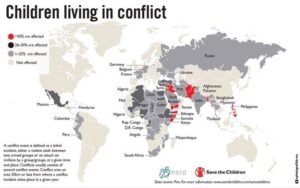- info@preciousfountain.org
- +234 806 870 0572

In conflict and disaster, children suffer first and suffer most. From humanitarian perspective, children are especially vulnerable to disease, malnutrition and violence. Children living in conflict areas are worst off as they are more likely to be living in extreme poverty, sickness, depression or not enrolled in primary school.
The chaos and insecurity of war threatens or destroys access to food, shelter, social support and health care, and results in increased vulnerability in communities, especially for children. Many humanitarian bodies like UNICEF and Save the Children focuses on these children and their families to provide them with the essential interventions required for protection, to save lives and to ensure the rights of all children, everywhere.
Hence, the need for sustainable interventions are important because crises are not one-time shocks; their impact can last for years.
Global Reports of Children in Emergency
Save the children recently published the War on Children report, which shows that the number of children living in conflict zones have increased by 75% in the last 20 years.
Save the Children concludes: “One in six children across the world are living in areas impacted by conflict, and children are more at risk in conflict now than at any time in the last 20 years. From Syria to South Sudan, Yemen to Democratic Republic of Congo, Afghanistan to Ukraine, children are caught up in violence, which is not of their making. Children are being killed and maimed, raped and recruited, and being denied aid and medical care. Warring parties are bombing schools and hospitals on a scale not seen for decades.”

Findings from the mappings reveal the following:
- In 2016, approximately 1.35 billion children under the age of 18 (59% of all children) were living in a conflict-affected country.
- In 2016, approximately 357 million children (that is, one in six) were living in a conflict zone.
- In 2016, approximately 165 million children were living in high intensity conflict zones, i.e. conflicts with more than 1,000 battle-related deaths.
- The number of children living in conflict zones has been steadily increasing since the year 2000, although the number of countries with armed conflicts has remained quite stable during the same period.
- Asia is the world region with the highest total number of children living in conflict zones.
- The Middle East is the world region in which a child has the highest probability of living in a conflict zone.
A Peep into the Long-term Effect
Failure to end crisis especially as it affects the health and overall growth of the young child would lead to years of negative impact resulting in;
- Illiteracy
- Effect of malnutrition
- Depression
- Long term psychological need
- Unsafe society
- Unproductivity
- Over dependence
- Increase in crime rate
- Breakdown in Governance
- Economic burden
Addressing the Needs
The mapping of children in conflict-affected areas has several implications for policy and further research.
First, the agencies who are actively working to mitigate the impact of war on children need to support the generation of more systematic knowledge on the various ways in which children are affected by armed conflict, both directly – through killing and maiming, child soldier recruitment, and sexual exploitation, and indirectly – through adverse health effects. In short, more resources should be invested in generating and managing data related to children and armed conflict across time and space.
Second, there is of course an urgent need to protect the more than 350 million children that live in conflict zones today. Concrete recommendations in this regard include the following:
- Providing access to quality continuing education, healthcare, food, clothing and shelter.
- Increasing aid to conflict-ridden countries in order to rebuild infrastructure and health systems
- Supporting peacekeeping operations in conflict-affected areas.
- Designing and upholding credible sanctions against armed groups in conflicts.
Rights for every child
- Every child is protected from violence and exploitation
- Every child has an equitable chance in life
- Every child learns
- Every child lives in a clean and safe environment
- Every child survives and thrives

No comment yet, add your voice below!